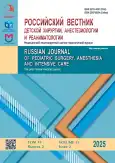男童嵌顿性腹股沟阴囊疝的手法复位方法
- 作者: Svarich V.G.1
-
隶属关系:
- Saint Petersburg State Pediatric Medical University
- 期: 卷 15, 编号 2 (2025)
- 页面: 193-198
- 栏目: Original Study Articles
- URL: https://journal-vniispk.ru/2219-4061/article/view/313001
- DOI: https://doi.org/10.17816/psaic1896
- EDN: https://elibrary.ru/IXMCFX
- ID: 313001
如何引用文章
全文:
详细
论证。嵌顿性腹股沟阴囊疝是儿童常见且严重的并发症,发生率相对较高(5.2%–24%),可能危及生命。尽管择期手术是较为理想的处理方式,但在保守治疗中也尝试应用手法复位技术以解除疝嵌顿,然而现有方法仍存在一定局限性与不足之处。
目的。评估作者提出的一种用于男童嵌顿性腹股沟阴囊疝的手法复位方法的优势。
方法。2020至2023年期间,共有67例嵌顿性腹股沟疝患儿收入外科病房。纳入标准为嵌顿时间不超过12小时,且无阴囊器官和腹腔器官并发症表现的嵌顿性腹股沟阴囊疝男童。主试验组包含17例患儿, 接受保守治疗联合新型手法复位。对照组为23例,接受保守治疗联合传统的全手指环绕轻压阴囊法。镇静后,先将疝囊手动塑形成漏斗状,其入口最小直径与腹股沟管外环直径相等。随后用一手五指环形固定该漏斗状疝囊,另一手的所有手指包绕疝囊其余部分,朝腹腔方向施加轻度压力,直至疝内容物完全自行复位。
结果。与传统手法复位方式相比,主试验组所采用的新方法在治疗嵌顿性腹股沟阴囊疝中展现出更高的保守治疗有效率和更短的操作时间(p < 0.05)。主试验组在手法复位过程中对疝囊施加的压力量也较小,从而显著降低了操作的创伤风险。
作者简介
Vyacheslav G. Svarich
Saint Petersburg State Pediatric Medical University
编辑信件的主要联系方式.
Email: svarich61@mail.ru
ORCID iD: 0000-0002-0126-3190
SPIN 代码: 7684-9637
MD, Dr. Sci. (Medicine)
俄罗斯联邦, Saint Petersburg参考
- Chang SJ, Chen JY, Hsu CK, et al. The incidence of inguinal hernia and associated risk factors of incarceration in pediatric inguinal hernia: a nation-wide longitudinal population-based study. Hernia. 2016;20(4):559–563. doi: 10.1007/s10029-015-1450-x
- Zamakhshary M, To T, Guan J, Langer JC. Risk of incarceration of inguinal hernia among infants and young children awaiting elective surgery. Can Med Assoc J. 2008;179(10):1001–1005. doi: 10.1503/cmaj.070923
- Wang K, Tan SS, Xiao Y, et al. Characteristics and treatments for pediatric ordinary and incarcerated inguinal hernia based on gender: 12-year experiences from a single center. BMC Surg. 2021;21:67. doi: 10.1186/s12893-020-01039-5
- Mulenga M, Bvulani B, Munkonge L. Risk of incarceration of inguinal hernias among paediatric patients awaiting elective surgery at the University Teaching Hospital, Lusaka, Zambia. Med J Zambia. 2018;45(4):189–195.
- Takehara H, Hanaoka J, Arakawa Y. Laparoscopic strategy for inguinal ovarian hernias in children: when to operate for irreducible ovary. J Laparoendosc Adv Surg Tech A. 2009;19(Sl):129–131. doi: 10.1089/lap.2008.0204.supp
- Dronov AF, Kozlov YA, Mokrushina OG, et al. Strangulated inguinal hernia in children. Russian Journal of Pediatric Surgery, Anesthesia and Intensive Care. 2013;3(3):87–96. EDN: RHWMRJ
- Razumovsky AYu. National guide to pediatric surgery. Moscow: GEOTAR-Media; 2021. 686 p. (In Russ.)
- Abdulhai SA, Glenn IC, Ponsky TA. Incarcerated pediatric hernias. Surg Clin North Am. 2017;97(1):129–145. doi: 10.1016/j.suc.2016.08.010
- Thapa B, Pun M. Manual reduction of incarcerated inguinal hernia in children. J Nepal Paediatr Soc. 2012;32(3):229–232. doi: 10.3126/jnps.v32i3.6146
- Yeap E, Nataraja RM, Pacilli M. Inguinal hernias in children. Aust J Gen Pract. 2020;49(1-2):40. doi: 10.31128/AJGP-08-19-5037
- Patent RUS № 2831106/ 02.12.24. Byul. No. 34. Svarich VG. Manual assistance method for strangulated inguinoscrotal hernia in boys. Available from: https://www.fips.ru/registers-doc-view/fips_servlet (In Russ.)
- Pawlak M, East B, de Beaux AC. Algorithm for management of an incarcerated inguinal hernia in the emergency settings with manual reduction. Taxis, the technique and its safety. Hernia. 2001;25:1253–1258. doi: 10.1007/s10029-021-02429-1
- Blandinskii VF, Nesterov VV, Sokolov SV, et al. Surgical treatment of inguinal canal hernias in boys: an analysis of five years’ experience. Creative surgery and oncology. 2019;9(1):37–43. doi: 10.24060/2076-3093-2019-9-1-37-43 EDN: ZHFVNZ
- Ozdamar MY, Karakus OZ. Testicular ischemia caused by incarcerated inguinal hernia in infants: incidence, conservative treatment procedure, and follow-up. Urol J. 2017;14(4):4030–4033. PMID: 28670671
- Rajput A, Gauderer MWL, Hack M. Inguinal hernias in very low birth weight infants: incidence and timing of repair. J Pediatr Surg. 1992;27(10):1322–1324. doi: 10.1016/0022-3468(92)90287-H
补充文件






